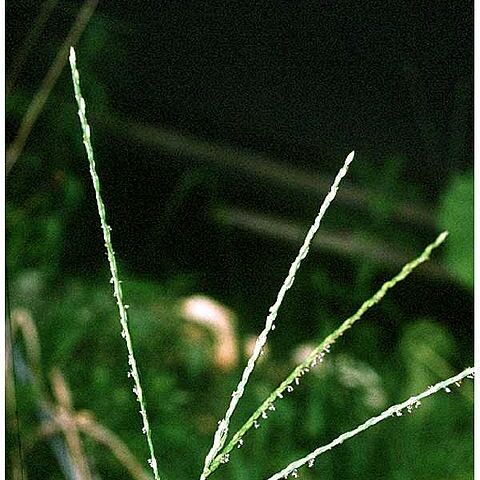Spikelets with one perfect terminal fl, single or in clusters of 2 or 3 on unequal pedicels along one side of an elongate rachis, forming 2–several slender, spike-like racemes; first glume minute or lacking; second glume a third to fully as long as the spikelet, conspicuously 5-or 7-veined; sterile lemma (appearing as another glume when the first glume is obsolete) about as long as the fertile one; fertile lemma leathery with hyaline margins, acute, often shining, usually faintly marked with longitudinal rows of minute pits; palea flat, similar in texture to the fertile lemma, which clasps its margins; ours weedy annuals, branched from the base, with few–several terminal, digitate or approximate, spike-like, one-sided racemes. (Syntherisma) 200+, cosmop.
Annual or perennial. Culms erect or decumbent, occasionally stoloniferous. Leaf blades linear or linear-lanceolate; ligule membranous. Inflorescence of digitately arranged racemes, sometimes on a short axis or with secondary branchlets, very rarely paniculate; spikelets usually in groups of 2–3(–4), imbricate to effuse, the latter often on notably long and unequal pedicels. Spikelets puberulous to villous, typically in stripes between the well-defined veins, rarely glabrous; lower glume absent or reduced to a little scale up to 1/4 spikelet length; upper glume variable; lower lemma usually ± equal to spikelet; upper floret pallid to black, apex subacute to acuminate, rarely apiculate. x = 9.
Spikelets solitary, in pairs, or in groups of 3-5, alternate in two rows on one side of a 3-angled, winged or wingless rachis, the first glume turned away from the rachis; first glume wanting, or present as a smaller or minute nerveless scale; second glume from much shorter to as long as the spikelet; sterile lemma as long as or slightly longer than the fruit, 5-nerved, the lateral nerves sometimes approxi-mate near the margin; fruit cartilaginous, pale or dark brown, the hyaline margins of the lemma not inrolled.
Spikelets pedicelled, 2–3(5)-nate, rarely solitary, 2-flowered, inferior floret barren, superior floret bisexual, slightly dorsiventrally compressed, more or less flattened on the front, convex to gibbous or basally spurred on the back, typically hairy between the nerves of the superior glume and inferior lemma, hairs unusually variable, rarely glabrous.
Superior lemma cartilaginous to chartaceous, rounded on the back, the flat, thin, semi-hyaline margins enfolding and concealing most of the palea, acute to acuminate, rarely aristate, longitudinal ornamentation more or less pronounced, pale to dark brown in fruit, often purplish tinged.
Inflorescence of 1-many racemes, variably arranged, from solitary along a common axis to digitate or in superposed whorls, sometimes with secondary branchlets; rhachis triquetrous, but often winged on two sides, bearing the alternate spikelet groups along the non-winged side.
Glumes 2, inferior glume small to absent, abaxial, superior glume from as long as (rarely much longer than) the inferior lemma to much shorter and exposing the superior lemma, membranous, often 3-nerved.
Inferior lemma usually as long as the spikelet (rarely much reduced), membranous, mostly 5–7-nerved, palea vestigial or absent.
Spikelet pedicels smooth to scabrous or variously hairy, sometimes with a coronula of long cilia, apex variously shaped.
Caryopsis mostly planoconvex, embryo 1/5–1/2 as long, hilum subbasal, small, punctiform to ellipsoid.
Styles 2, shortly connate at the base, stigmas plumose, often purplish.
Palea nearly as long as superior lemma, not or faintly 2-nerved.
Annuals or perennials with variable habit.
Lodicules 2, cuneate, flat.
Anthers 3.


